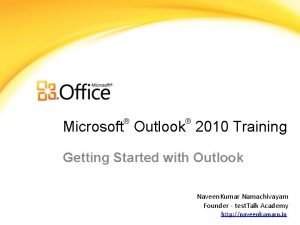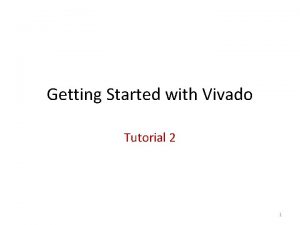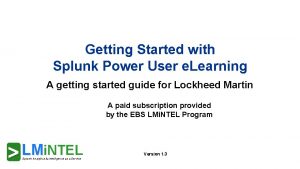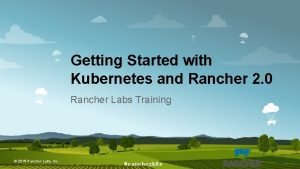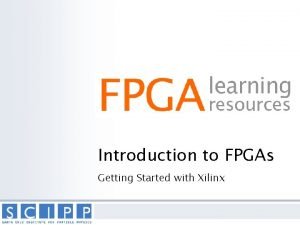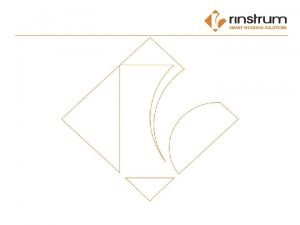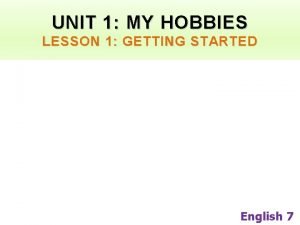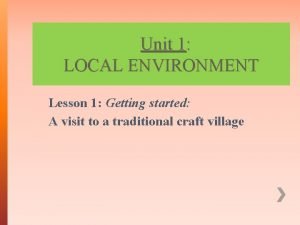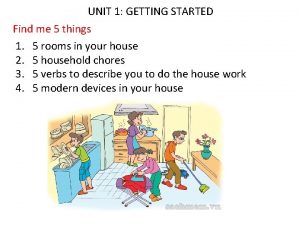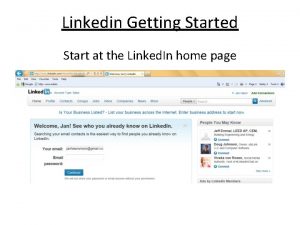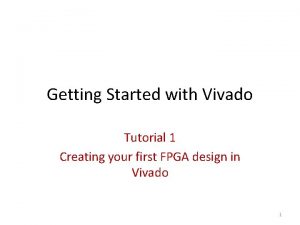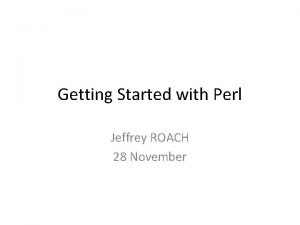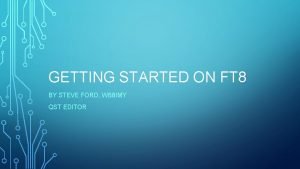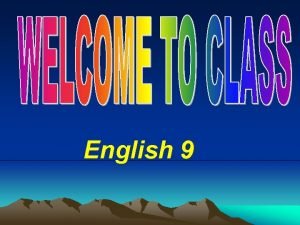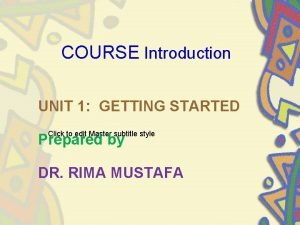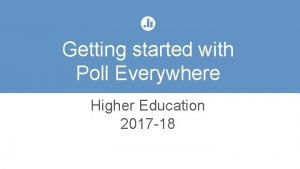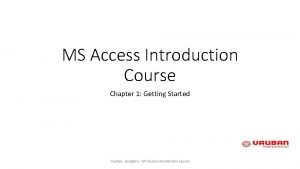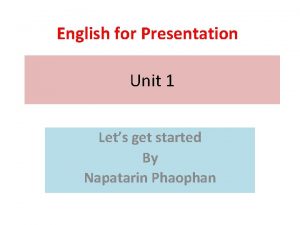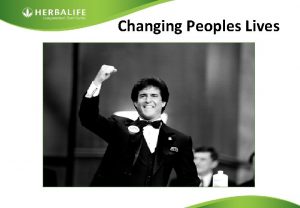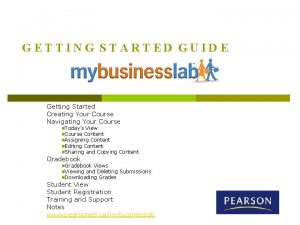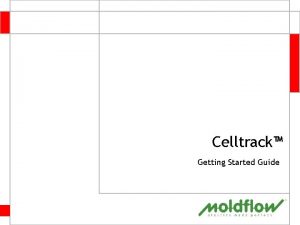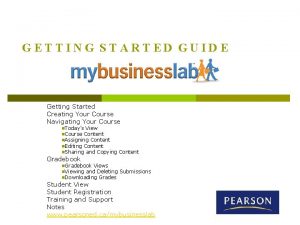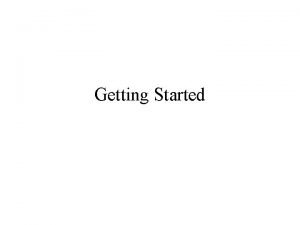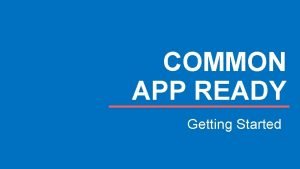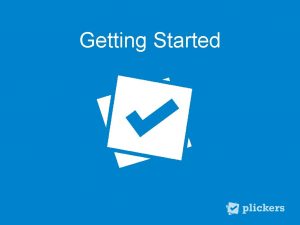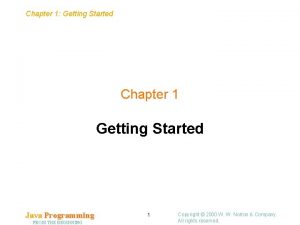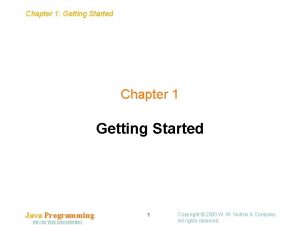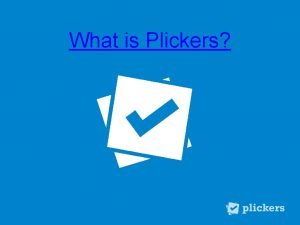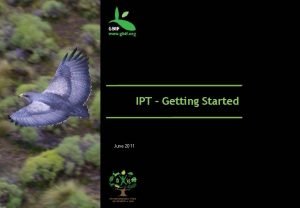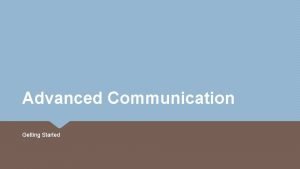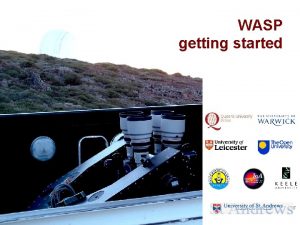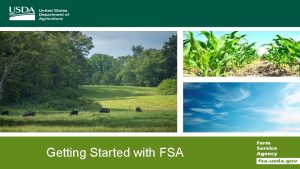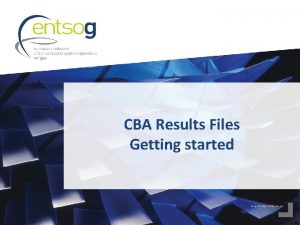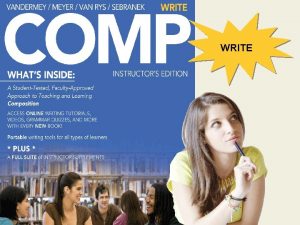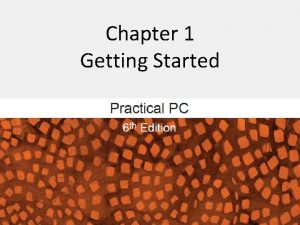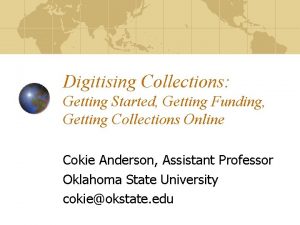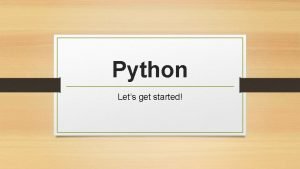LEARNING PLANS A GUIDE TO GETTING STARTED Learning































- Slides: 31

LEARNING PLANS A GUIDE TO GETTING STARTED Learning Plan Ad Hoc Committee Summer 2012

What is a Learning Plan? Method to organize and individualize learning needs (Young & Patterson, 2007). Student initiated and driven Flexible and may be changed to accommodate student interest , learning style, and opportunities in the practice setting (Royle et al, 2001) Part of life long learning process (Knowles, 1975) A record of professional accountability (CARNA, 2006)

Steps in Learning Plan Development Learning Plan Nursing Process Step 1: Engage in practice experience reflection Step 2: Identify learning needs (goals) Assessment Step 3: Identify the CARNA Practice Standard Indicator Step 4: Develop specific learning objectives Step 5: Identify learning activities and strategies Planning Step 6: Identify evidence of learning (how you will know if you have accomplished the objectives) Step 7: Discuss learning plan with practice instructor Step 8: Implement learning plan Implementation Step 9: Reflection of learning (ongoing) Evaluation

Step 1 Practice Experience Reflection CARNA self-reflection definition: “. . involves the active review of one's own nursing practice to determine learning needs, gain validation of one's practice through feedback from others, and plan appropriate ways to meet one's learning needs. ” Retrieved from https: //www. nurses. ab. ca/Carna/index. aspx? Web. Structure. ID=5799

Self-Reflection Self assessment is required to identify learning needs (Knowles, 1975) Self assessment: a personal self evaluation of one’s professional attributes and abilities against a perceived norm” (Colthart et al. , 2008, p, 141). As a starting point you may: consider what you want to learn OR reflect on positive learning experiences first, then move to considering what you want to learn

To stimulate reflection on positive learning experiences ask yourself: Reflect on successful learning experiences in practice you have experienced, how did that feel? What did you learn from that experience, was it memorable? How did you know you were successful in that experience? Did you plan that experience or was it spontaneous? Describe what a successful learning experience will look like for this practice experience

To determine what you need to learn consider: Program goals and objectives Course expectations/objectives. Your learning plan will reflect, relate or go beyond the overall course objectives CARNA Practice Standards and the CNA Code of Ethics CARNA Entry to Practice Competencies for the Registered Nurses Profession Previous learning Practice setting. What do you need to know to work in that area?

Step 2 Identify your learning needs From identifying your learning needs you can develop learning goals. Learning goals are broadly stated, brief statements of what you would like to accomplish in the practice setting based on the self reflection. Form the base for the development of specific learning objectives

Identify your learning goals…… Learning Needs Previous knowledge relevant to the practice setting Program and course outcomes Relevant CARNA documents Practice Setting You may ask: “At the end of the rotation……: • Where do I want to be? ” (desired level of competency) • Where do I need to be? ” (required level of competency) • Where am I now? ” (present level of competency)

Example Learning Goal: To enhance my communication skills and collaboration within the nursing practice environment

Step 3 Identify the CARNA Nursing Practice Standard Indicator(s) that correlates with your goal CARNA Nursing Practice Standards are: Professional Responsibility Knowledge-Based Practice Ethical Practice Provision of Service to the Public

Example Learning Goal: To enhance my communication skill and collaboration within the nursing practice environment. The correlating CARNA Practice Standard/Indicator is: NPS: Provision of service to the public Indicator 4. 2 The registered nurse uses communication and

Step 4 Develop specific learning objectives A statement that provides a focus for learning Address 3 domains of learning (ASK Criteria) Are SMART specific measurable achievable realistic/relevant

Objectives describe the: Audience expected to perform behavior Behavior that learner will engage in Condition(s) under which objectives are obtained Degree of competency expected upon completion of the objective (Van Melle & Pinchin, 2008)

Objective Example I (audience) will consistently (degree of competency) engage in thorough and concise reports (behaviour) when handing off client care, working with the team, and communicating with other staff/HCPs (conditions)

ASK Domains of Learning Each goal must contain the following three learning domains: 1. 2. 3. Attitude (affective) Skills (psychomotor) Knowledge (cognitive)

Please Note One objective may blend the domains of learning For example, you may have an objective that blends a skill and knowledge domain: I will perform aseptic procedures competently (S) by incorporating foundational principles of asepsis and AHS appropriate policy and/or procedure (K) To make your goal complete, between the three objectives, all three learning domains (ASK) must be represented.

Attitude (Affective) How we deal with things emotionally. Attends to values, attitudes, beliefs, ethical reasoning and application Increasing level of complexity Receiving Awareness of and willingness to receive. Being aware of something in the environment. Asks Describes Identifies Names Uses Responding Active participation with the phenomena. Valuing Showing a stating commitment and integration of the phenomena Answers Show Discusses Helps Performs Completes Demonstrates Express Shares Follows Organization Integrating new values into one’s behaviour -creating a unique value system. Accepts and integrates professional ethical standards Arranges Defends Explains Integrates Compare Eg: I will describe components of respect in the classroom on Dec, 2012. Eg. I will show respect in the classroom by not interrupting in all Pro Sem classes. Eg. I will demonstrate respect in all classroom interactions in Pro Sem Eg. I will explain how various classroom behaviours impact on respect during the 6 th week of classes in Pro Sem. Characterization Making judgements about the values of ideas. Embodies professional ethical standards Appraises Acts Practices Proposes Qualifies Eg. I will act respectively in all classroom interactions by…

Skills (Psychomotor) Includes physical movement, coordination and the use of motor skill Increasing level of complexity Imitation Patterning behaviour after someone else Copy Imitate Manipulation Able to perform certain skills by following instruction or practicing Complete Follow Precision Becoming more exact with few errors. Perform independently. Master Perform Articulation Coordinating a series of actions and achieving internal consistency. Adapt Customize Naturalization High level of performance – action becomes automatic and consistent Perfectly Naturally

Knowledge (Cognitive Domain) Involves knowledge and the development of intellectual skills Increasing level of complexity Knowledge Comprehension Application Information Interpret Use the recall information in knowledge or one’s own generalize it words to a new situation Define Label List Match Name Recall Repeat Order Reproduce State Classify Describe Discuss Explain Identify Locate Recognize Report Review Select Analysis Break down the knowledge into parts & show relationship among the parts Apply Analyze Choose Calculate Demonstrate Categorize Employ Compare Interpret Contrast Operate Differentiate Prepare Distinguish Practice Test Solve Use Synthesis Bring the parts together to form a whole and create new meaning or structure Arrange Compose Create Manage Organize Plan Prepare Synthesize Evaluation Make judgements on the basis of given criteria Argue Assess Compare Defend Justify Predict Rate Support

Step 5 Learning Activities and Strategies First, take inventory. . . What resources (people, literature, policy, equipment) are available? What experiences or opportunities (types of patients/groups, practice setting) can I seek out? Who (instructor, staff, peers) can I collaborate with? What personal strengths or weaknesses do I possess that can promote/hinder learning? Then, develop specific activities and strategies from your inventory to meet objectives

Potential Resources to Consider Resource personal Educators Clinical nurse specialists Multidisciplinary team Texts/journals Policy and procedures Tutorials Observation in practice setting Attendance at workshop Interviews Audio-visual materials Lab practice **Be specific with identifying resources (ie: what textbook, how many journals, what policy, what workshop, etc)**

Step 6 Evidence of Learning (Identify how you will accomplish your objectives) Determine who (self, instructor, peers, staff, patients, families) will evaluate your learning Determine what they will evaluate. Determine how the evaluation will occur. Ask how you, and others, will know that you have met your learning objectives. How will you, your behaviour and/or your nursing practice be different when the objectives have been met? Identify how the evidence will be presented or demonstrated.

Additional Potential Sources of Evidence Verbal dialogue and discussion Journal/Reflection Research paper Tangible resource/ template Demonstration/ Incorporation of… Poster Practice performance evaluation

Step 7 Discuss the Learning Plan Discuss with your practice instructor and/or other persons who are identified as evaluators. Revise learning plan based on discussion and feedback

Step 8 Implement the Learning Plan Follow through with the learning plan by implementing the activities and strategies and working towards the evidence of learning. Document your reflections of learning

Step 8 Reflections of Learning As the owner of your learning plan engage in ongoing assessment/reflection of learning progress through written documentation on your learning plan (be specific about experiences, dates, insights, feedback, etc) Carry out a formal review of the learning plan progress with the practice instructor/evaluator at midterm and final meetings.

L Ob earn jec in tiv g e 2 Learning Activities and Strategies Activities/strategies is the rain that is vital for life’s accomplishments. They support the learning need and impact learner success. ing arn e 3 Le ctiv je Ob L Ob ea je rnin ct iv g e 1 The goal is global, broad & overarching: like the solar system or umbrella canopy CARNA Nursing Practice Standards tie relevancy to the nursing profession Goal CARNA Nursing Practice Standards Objectives are the spokes of the umbrella or the clouds that set the foundation for life. They provide a focus and structure for learning. Learning Activities and Strategies Evidence is visible by the growth of fresh green grass. Learning and reflection of learning demonstrate personal and professional growth. Evidence of Learning and Reflections of Learning

NESA BN Programs Learning Plan Template (Draft) Name Course # Instructor Practice Setting Practice Year LEARNING GOAL: NPS: Learning Objectives Learning Activities & Strategies Reflections of Success (please date all narrative entries) Evidence of Learning

“BEING AN EXPERT NURSE MEANS BEING COMMITTED TO LIFE LONG REFLECTION ON YOUR NURSING PRACTICE AND ONGOING LEARNING. BY DEVELOPING LEARNING PLANS, YOU HAVE A ROAD MAP OF WHERE YOU ARE GOING AND HOW YOU ARE GOING TO GET THERE”. (J. GLOVER P. 6)

References College and Association of Registered Nurses of Alberta. (2006). Entry to practice competencies for the registered nurses profession. Retrieved from http: //www. nurses. ab. ca/Carna. Admin/Uploads/Entry-to-Practice%20 Competencies. pdf Clark, D. (2000). Learning domains of Bloom’s taxonomy. Retrieved from http: //www. nwlink. com/~donclark/hrd/bloom. html Colhart, I. , Bagnall, G. , Evans, A. , Allbutt, H. , Haig, A. , Illing, J. , & Mc. Kinstry, B. (2008). The effectiveness of self-assessment on the identification of learning needs, learning activity, and impact on clinical practice: BEME Guide no. 10. Medical Teacher, 30(2), 124 -145. doi: 10. 1080/0142159070188. Glover, J. (2009). Learning Plan 2009. A module in development by J Glover, NESA Instructor. Knowles, M. (1975). Self-directed learning: A guide for learners and teachers. Parsippany, NJ: Cambridge Adult Education. Royle, J. A. , Sword, W. , Black, M. , Brown, B. , & Carr. T. (2001). Developing clinical opportunities and resources for problem based learning. In E. Ridout (Ed), Transforming nursing education through problem-based learning (pp. 239 -258). Canada: Jones and Bartlett Publishers. Young, L. E. , & Patterson, B. L. (2007). Glossary. In L. E. Young & B. L. Patterson (Eds), Teaching nursing: Developing a student-centered learning environment (pp. 557 -580. Philadelphia, PA: Lippincott Williams & Williams. Van Melle, E. , & Pinchin, S. (2008). Writing Effective Learning Objectives. Retreived from http: //www. entcanada. org/Word_Files/Creating. Learning. Objectives. pdf
 The secret to getting ahead is getting started
The secret to getting ahead is getting started Outlook tutorial 2010
Outlook tutorial 2010 Getting started with vivado ip integrator
Getting started with vivado ip integrator Getting started with unix
Getting started with unix Education.splunk.com
Education.splunk.com Rancher get started
Rancher get started Getting started with excel
Getting started with excel Getting started with xilinx fpga
Getting started with xilinx fpga Getting started with lua
Getting started with lua English 7 unit 1 getting started
English 7 unit 1 getting started Unit 1 getting started
Unit 1 getting started Unit 1 getting started
Unit 1 getting started Infuecers gone wild
Infuecers gone wild Getting started with vivado
Getting started with vivado Perl read_file
Perl read_file Getting started with ft8
Getting started with ft8 English 9 unit 3 getting started
English 9 unit 3 getting started Unit 1 getting started
Unit 1 getting started Getting started with poll everywhere
Getting started with poll everywhere Android development getting started
Android development getting started Getting started with access
Getting started with access Getting started with eclipse
Getting started with eclipse Mathematica getting started
Mathematica getting started Cuadro comparativo e-learning b-learning m-learning
Cuadro comparativo e-learning b-learning m-learning When was globalization started
When was globalization started What is urdu hindi controversy
What is urdu hindi controversy When islam started
When islam started Cpd law summary
Cpd law summary Samaritan's purse history
Samaritan's purse history Let's get started presentation
Let's get started presentation What started the cold war
What started the cold war The founder of herbalife
The founder of herbalife

